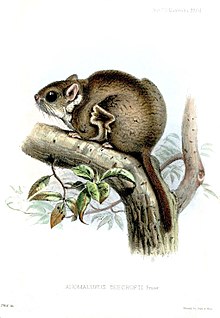Anomalure
This article needs additional citations for verification. (November 2007) |
| Anomalures Temporal range: Late Eocene to recent[1]
| |
|---|---|

| |
| Anomalurus beecrofti, Beecroft's flying squirrel Artist: Joseph Wolf, 1851 | |
| Scientific classification | |
| Kingdom: | Animalia |
| Phylum: | Chordata |
| Class: | Mammalia |
| Order: | Rodentia |
| Suborder: | Anomaluromorpha |
| Family: | Anomaluridae Gervais in d'Orbigny, 1849 |
| Type genus | |
| Anomalurus Waterhouse, 1843
| |
| Genera | |
| |
The Anomaluridae are a family of rodents found in central Africa.[2] They are known as anomalures or scaly-tailed squirrels. The six extant species are classified into two genera.
All anomalurids have membranes between their front and hind legs like those of a flying squirrel, but they are not closely related to the flying squirrels that form the tribe Petauristini of the family Sciuridae. They are distinguished by two rows of pointed, raised scales on the undersides of their tails.[3] The anatomy of their heads is quite different from that of the sciurid flying squirrels.
Most anomalurid species roost during the day in hollow trees, with up to several dozen animals per tree. They are primarily herbivorous, and may travel up to 6 km (3.7 mi) from their roosting tree in search of leaves, flowers, or fruit, although they also eat a small amount of insects. They give birth to litters up to three young, which are born already furred and active.[3]
Anomalurids represent one of several independent evolutions of gliding ability in mammals, having evolved from climbing animals.[4] The others include the true flying squirrels of Eurasia and North America, colugos or flying lemurs of Southeast Asia, and the marsupial gliding possums of Australia.
Taxonomy[]
Taxonomy follows Fabre et al. 2018.[5]
- Family Anomaluridae
- Genus Anomalurus
- Beecroft's flying squirrel, Anomalurus beecrofti
- Lord Derby's scaly-tailed flying squirrel, Anomalurus derbianus
- Pel's flying squirrel, Anomalurus pelii
- Dwarf scaly-tailed squirrel, Anomalurus pusillus
- Genus Idiurus
- Long-eared flying mouse, Idiurus macrotis
- Pygmy scaly-tailed flying squirrel, Idiurus zenkeri
- Genus Anomalurus
Fossil genera[]
Several fossil genera are also known:
References[]
- ^ "Mindat.org". www.mindat.org. Retrieved 2021-06-12.
- ^ Dieterlen, F. (2005). "Family Anomaluridae". In Wilson, D.E.; Reeder, D.M (eds.). Mammal Species of the World: A Taxonomic and Geographic Reference (3rd ed.). Johns Hopkins University Press. p. 1533. ISBN 978-0-8018-8221-0. OCLC 62265494.
- ^ a b Fleming, Theodore (1984). Macdonald, D. (ed.). The Encyclopedia of Mammals. New York: Facts on File. pp. 632. ISBN 0-87196-871-1.
- ^ Fabre, Pierre‐Henri; Tilak, Marie-Ka; et al. (June 2018). "Flightless scaly‐tailed squirrels never learned how to fly: a reappraisal of Anomaluridae phylogeny". Zoologica Scripta. 47 (4): 404–417. doi:10.1111/zsc.12286.
- ^ Fabre, Pierre-Henri; Tilak, Marie-Ka; Denys, Christiane; Gaubert, Philippe; Nicolas, Violaine; Douzery, Emmanuel J. P.; Marivaux, Laurent (July 2018). "Flightless scaly-tailed squirrels never learned how to fly: A reappraisal of Anomaluridae phylogeny". Zoologica Scripta. 47 (4): 404–417. doi:10.1111/zsc.12286.
- ^ Sallam, Hesham M; Seiffert, Erik R.; Simons, Elwyn L., Brindley, Chloe. A Large-bodied Anomaluroid rodent from the earliest late Eocene of Egypt: Phylogenetic and biogeographic implications. Journal of Vertebrate Paleontology 30(5):1579–1593, September 2010.
- Anomalures
- Rodents of Africa
- Extant Eocene first appearances
- Taxa named by Paul Gervais